Last updated on December 29th, 2023 at 09:49 pm
With the huge number of microphones available to us, it’s no wonder that when it is time to buy one, we can’t seem to make up our mind: Between USB and XLR, Cardioid, Supercardioid, and multipattern microphones, plus considering that there’s almost an infinite number of brands out there selling them, it can be a tough choice.
This is why I decided to write this article since I don’t want you to make any unnecessary mistakes where you end up losing money or having to return the microphone you bought.
I will list 7 XLR and 6 USB microphones as well as give you my top recommendations right at the end.
- Best USB Microphones Under $50
- Best XLR Microphones under $50
- You will need an Audio Interface
- Shure SM48 Cardioid Dynamic Microphone
- Behringer XM8500 UltraVoice Dynamic Cardioid Microphone
- Pyle-Pro PDmic58 Cardioid Dynamic Microphone
- Behringer C-1 Cardioid Condenser Microphone
- TONOR Pro Condenser Microphone Kit
- Neewer NW-700 Condenser Microphone
- Behringer Ultravoice XM1800S (3 Dynamic Microphone Set)
- My Top Four Choices
- Conclusion
Best USB Microphones Under $50
| Microphone | Type | Polar Pattern | Build Quality | Frequency Response | Sampling Rate | Audio Quality |
|---|---|---|---|---|---|---|
| Fifine k669B | Condenser | Cardioid | ++ | 20 to 20,000 Hz | 48kHz/16bit | +++ |
| Samson Go | Condenser | Cardioid | +++++ | 20 to 18,000 Hz | 44.1kHz/16bit | ++++ |
| Blue Snowflake | Condenser | Cardioid | ++++ | 35 to 20,000 Hz | 44.1kHz/16bit | ++++ |
| Blue Snowball iCE | Condenser | Cardioid | +++ | 40 to 18,000 Hz | 44.1kHz/16bit | +++++ |
| Moano AU-A04 | Condenser | Cardioid | +++ | 30Hz-16kHz | 192khz/24bit | +++++ |
If you’re an absolute beginner or if you know that you will only use the one mic, then USB microphones are a great choice since they are plug n’ play devices, which simply means that you connect them to your PC and they are ready to be used.
No installation of drivers is required, as well as an audio interface, mixer or phantom power supply.
They can’t, however, be used in live performances or be connected to an Audio Interface.
Also, with USB microphones you can only record one track at a time.
Fifine K669B Cardioid Condenser Microphone
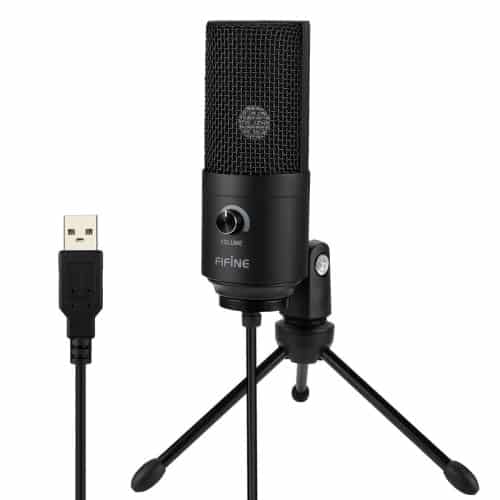
This is a Plug and play USB Cardioid Condenser microphone that comes with a 5.9-Foot included USB Cable, and it is designed for Voice-over work as well as for recording anything voice-related, like podcasts and YouTube videos.
I wouldn’t recommend it for recording music since the sound quality just isn’t that high.
One pro about the Fifine k669B is that it has a metal body as well as a very rugged grille; However, with how cheap it is, don’t expect it to be built like an Audio-Technica or Rode mic.
The only feature is the volume knob on the front.
All in all, the Fifine k669B is a very simple yet good-sounding microphone with just a cardioid polar pattern, which is the pattern you will be using anyway 99% of the time.
It is a very cost-efficient microphone that should be more than enough for doing voice-over work or creating YouTube Content.
If you’re just starting out, get this one!
Specifications
| Polar Pattern | Cardioid |
| Microphone type | Condenser |
| Frequency Response | 20 to 20,000 Hz |
| Sampling Rate | 48kHz/16bit |
| Sensitivity | -34db |
| Connector | USB |
Find out more about the Fifine k669B here:
- Fifine k669B: Amazon.
Samson Go Mic Portable Multi-Pattern USB Microphone
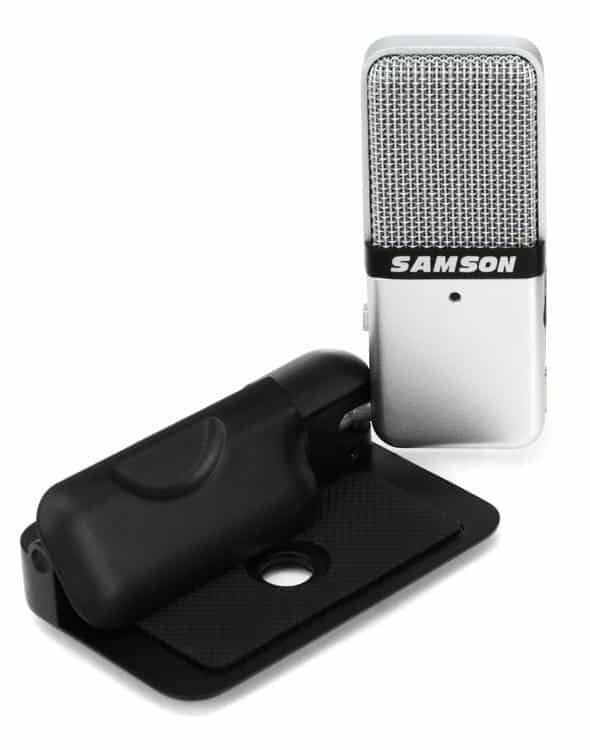
The Samson Go is a surprisingly small and compact microphone designed to be portable and convenient.
It features a swivel arm that folds out in order to get the mic into position, which is quite different from most other microphones since they tend to need a tripod.
Because of its small size and low weight, it can be clipped to your PC or Laptop screen to be used, which makes it pretty versatile.
The Samson Go features dual cardioid capsules which allow you to use it as a cardioid Microphone or as an Omnidirectional Microphone.
This means that it can be used as a regular directional microphone, where you want to just pick up the sound in front of it, or as a conferencing microphone that can pick up everything around it.
One added feature is the software that comes with it called “Music Creating Software” which will allow you to do some noise cancellation if needed.
When taking a look at its build quality you’ll find that the body is all metal, which is something I didn’t expect since most cheap USB microphones, and even more expensive ones, are made of plastic.
One additional feature is that it provides a -10dB PAD, should you need to record a very loud source.
If you’re looking for a portable microphone that’s built to last and is extremely versatile because of its polar patterns, then the Samson Go might the ideal choice for you.
Recommended for conference calls and talking over Skype.
Specifications
| Polar Pattern | Cardioid |
| Microphone type | Condenser |
| Frequency Response | 20 to 18,000 Hz |
| Sample Rate | 44.1kHz |
| Bit Depth | 16-bit |
| Connector | USB |
Find out more about the Samson Go here.
- Samson Go: Amazon, Sweetwater.
Blue Snowflake Portable Condenser USB Microphone
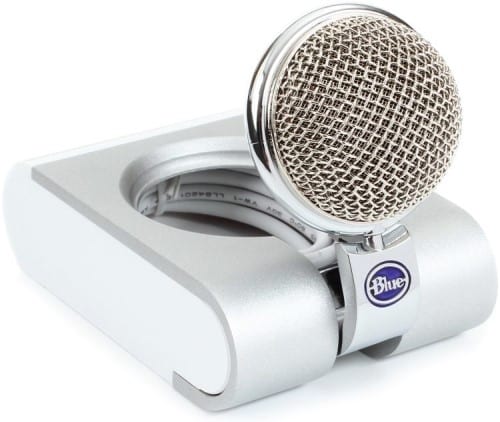
The Blue Snowflake is a microphone designed to fit on top of your PC/Laptop screen, which means that it’s a small and compact microphone, ideal for recording on the go.
This microphone literally fits in your pocket, it’s that small.
It’s definitely not designed to be used as a professional music recording device but it’s excellent for talking over Skype, Discord, etc., or for recording music while traveling if you just want to lay down some ideas.
The build quality is pretty decent since everything is made out of metal except for the back of the microphone.
The Blue Snowflake could be closely compared to the Samson Go because of its small size and portability.
In my honest opinion, the Samson Go is the better choice here mainly because they sell for roughly the same but you get more versatility with the Samson Go.
Still, the Blue Snowflake offers a lot of value.
Specifications
| Polar Pattern | Cardioid |
| Microphone type | Condenser |
| Frequency Response | 35 to 20,000 Hz |
| Sample Rate | 44.1kHz |
| Bit Depth | 16-bit |
| Connector | USB |
Find out more about the Blue Snowflake here:
- Blue Snowflake: Amazon.
Blue Snowball iCE USB Cardioid Condenser Microphone
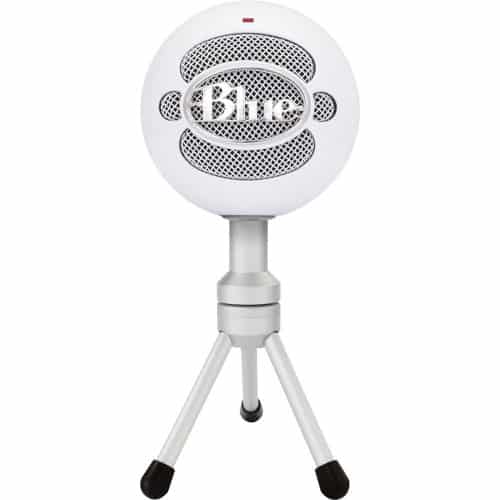
The Blue Snowball iCE is the “light” version of the Blue Snowball, and by this, I mean that it simply has one cardioid polar pattern instead of also featuring the Omni one.
The whole body of the microphone is made out of plastic which, even though I don’t like plastic microphones, feels pretty sturdy.
Look wise it’s a completely different microphone than most of the ones out there since it’s just a round ball with a metal grille on the front.
It is a plug n’ play microphone compatible with both Windows and Mac OS, meaning that you just need to connect it and that’s it.
The audio quality is great and it can be used even to record some instruments-, like acoustic guitar, quite well.
However, if you’re a musician, then I think that none of the USB microphones on this entire list will yield good enough results. In that case, I’d recommend you check out this post about the best USB microphones I wrote a while back.
Specifications
| Polar Pattern | Cardioid |
| Microphone type | Condenser |
| Frequency Response | 40 to 18,000 Hz |
| Sample Rate | 44.1kHz |
| Bit Depth | 16-bit |
| Connector | USB |
Find out more about the Blue Snowball iCE here:
Blue Snowball iCE: Amazon.
And lastly…
Maono AU-A04
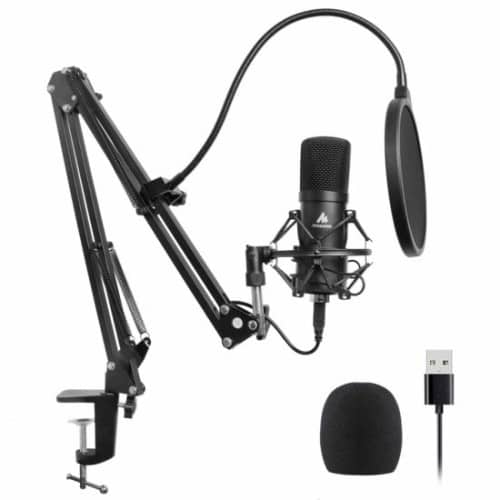
The first thing that jumped to my attention is the sampling rate of this mic since it’s 192kHz/24Bit, which is much higher than the usual 44.1kHz or 48kHz.
While you certainly could get the mic on its own, there’s also a whole set available that includes a shock mount, a boom arm, a foam windscreen, and a pop filter, for just a bit more.
Now, since it’s a budget mic, it doesn’t include any of the features you see on other USB microphones; like the Mute Button, Gain control, more than one polar pattern, etc.
This is why it’s a fantastic beginner microphone.
For anyone who is interested in podcasting, streaming, doing voice-overs, or anything voice-related, the Moano AU-A04 offers everything you need at a very low price.
Specifications
| Polar Pattern | Cardioid |
| Microphone type | Condenser |
| Frequency Response | 30Hz-16kHz |
| Sample Rate | 192khz |
| Bit Depth | 24-bit |
| Connector | USB |
Find out more about the Moano AU-A04 here.
Best XLR Microphones under $50
| Microphone | Type | Polar Pattern | Build Quality | Frequency Response | Audio Quality |
|---|---|---|---|---|---|
| Shure SM48 | Dynamic | Cardioid | +++++ | 55Hz – 14kHz | +++++ |
| Behringer XM8500 | Dynamic | Cardioid | +++++ | 50Hz – 15kHz | ++++ |
| Pyle-Pro Pdmic58 | Dynamic | Cardioid | ++++ | 50Hz – 15kHz | +++ |
| Behringer C-1 | Condenser | Cardioid | +++++ | 40Hz – 20kHz | +++++ |
| Tonor Pro | Condenser | Cardioid | +++ | 20Hz 12kHz | +++ |
| Neewer NW-700 | Condenser | Cardioid | +++ | 20Hz – 20kHz | +++ |
| Ultravoice XM1800S | Dynamic | Super-cardioid | ++++ | 80 to 15,000 Hz | ++ |
Before I get into the list of the best XLR microphones under $50, there is one very important thing you need to know.
You will need an Audio Interface
XLR microphones usually require an Audio Interface to be connected to your PC, and while there are some very affordable ones out there, this will significantly increase the overall cost.
Still, this is the route I would recommend to most people since it allows you to record multiple microphones at once, and the upgrade path is also much simpler than going with a USB microphone.
What I mean is that if you purchase a USB mic and you want to upgrade later on, you would still need to buy a good quality Audio Interface AND XLR microphones.
Also, it’s important to note that Audio Interfaces can provide 48v phantom power which is going to power your condenser microphones (click on the link to find out what phantom power is and how it works).
One last benefit of XLR microphones is that they can be used for live performances since they can be connected to PA systems.
USB mics, on the other hand, can’t be used for that purpose.
Ok, now that that’s out of the way, let’s get on with it!
Shure SM48 Cardioid Dynamic Microphone

The Shure SM48 is an incredibly affordable XLR microphone, and the great thing is that since it’s an XLR Dynamic mic, it can be connected to your PC via an XLR to USB cable, or an XLR to 3.5mm cable.
You can get one with an On-Off switch which will cost you a bit more, but still, price won’t be an issue.
It is a great alternative to the Shure SM58, especially considering that it’s much more affordable while sounding very similar.
This Microphone has a built-in pop-filter, but you will need to use an external one if you want to completely avoid plosives.
The build quality of the SM48 is extremely good, you could drop it a hundred times and it would still work fine.
The sound quality is just great; It sounds clear and crisp, not as good as the SM58, but the differences are hardly noticeable and in a live setting you really will not be able to tell the difference.
It comes with a bass roll-off that helps control the proximity effect, plus a mid-boost to help the vocals cut through the mix a bit better.
This mic provides good feedback- and handling noise rejection as well as off-axis rejection.
The SM48 is a fantastic choice for karaoke, band practice, backup vocals, or for recording music at home.
Specifications
| Polar Pattern | Cardioid |
| Microphone type | Dynamic |
| Frequency Response | 55 to 14,000 Hz |
| Output Impedance | Rated impedance is 150 Ohms (300 Ohms actual) |
| Connector | Three-pin (XLR), male |
Find out more about the Shure SM48 here:
- Shure SM48: Amazon, Sweetwater.
Moving on…
Behringer XM8500 UltraVoice Dynamic Cardioid Microphone
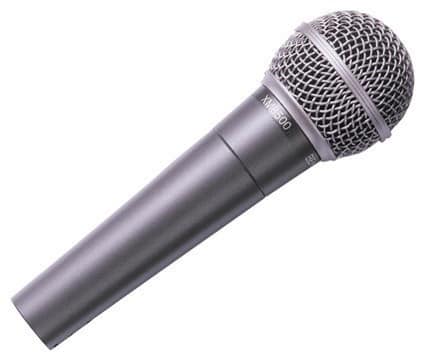
The Behringer XM8500 is a fairly popular handheld cardioid microphone known for its great cost-quality ratio.
It doesn’t provide any outstanding features which is is to be expected, considering the price.
If feels extremely durable; The build quality is just fantastic and it absolutely looks like it could take a beating and keep on working like nothing happened.
Since it’s a Dynamic XLR microphone it can be used for live performances as well as recording at home, and the great thing is that thanks to it being a dynamic cardioid microphone, it can handle high SPL and reject feedback quite well.
The frequency response ranges from 50Hz all the way up to 15kHz which is the standard frequency response for vocal dynamic mics.
Like most vocal microphones, it has a slightly boosted mid-range to help emphasize the vocals and to allow them to better cut though the mix.
One con about the XM8500 is that plosives can be a real issue; it does come with an internal pop filter which should, hopefully, reduce the plosives, and while this does somewhat work for live performances, I would highly recommend using an external one when recording at home.
All in all, this is an excellent microphone when taking cost-efficiency into account.
If I had to choose between this one and the SM48 however, I’d recommend the since it does sound slightly better.
Still, this is a very cost-efficient microphone and it’s definitely worth the money.
Specifications
| Polar Pattern | Cardioid |
| Microphone type | Dynamic |
| Frequency Response | 50 to 15,000 Hz |
| Output Impedance | Rated impedance is 150 Ohms |
| Connector | Three-pin (XLR), male |
Find out more about the Behringer XM8500 on Amazon here.
- Behringer XM8500: Amazon.
Pyle-Pro PDmic58 Cardioid Dynamic Microphone
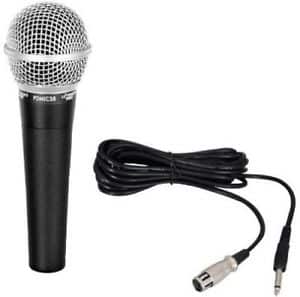
The PDmic58 is Pyle’s answer to Shure’s hugely popular SM58… but at literally 1/8th of the price.
This is by far the cheapest XLR microphone on this list and to be honest, it’s quite impressive, all things considered.
The build quality isn’t bad at all, in fact, it’s very similar to the one of the Behringer XM8500 and the Shure SM48.
It’s got an all-metal body and metal grille and it just feels good when holding it since it does have some decent weight to it.
However, it does feel a bit lighter which means that either the components inside are lighter or the casing itself is lighter, therefore being less resistant.
Now, one con about this one is that it does sound a little too bright and you may need to address this by reaching for the EQ.
Another con is that it comes with an XLR to ¼” microphone cable which I’d hope was an XLR-XLR one, since you may need to get an XLR-XLR cable for live use.
If you are on an extreme budget and can’t afford the SM48, then this one might suit your needs!
Just remember that you may need to invest in an additional XLR cable.
Specifications
| Polar Pattern | Cardioid |
| Microphone type | Dynamic |
| Frequency Response | 50 to 15,000 Hz |
| Output Impedance | 600 Ohms |
| Connector | Three-pin (XLR), male |
Find out more about the Pyle-Pro PDmic58 here:
- Pyle-Pro PDmic58: Amazon.
Behringer C-1 Cardioid Condenser Microphone
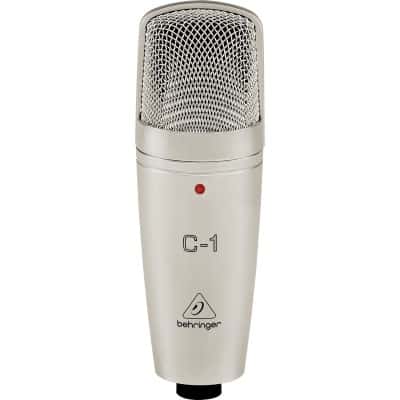
Behringer has always been known as the brand able to create budget equipment that works and sounds great.
The Behringer C-1 is the same microphone as the Behringer C-1U, with the difference being that the C-1U is the USB version of the two and is about $10 more expensive.
I didn’t include the USB version of the mic in this list because it’s a bit over $50, however, it’s a great alternative to any of the USB mics that I will be listing later on.
One very important thing to note is that the Behringer C-1 requires 36v–48v of phantom power.
Some other microphones may require anywhere from 12v to 48v, but you need to make sure that your Audio Interface or mixer can supply enough of it, otherwise, it won’t work (99% of audio interfaces supply it, however).
The build quality is great, as is the carrying case that comes with it; it even seems too much for a mic that is this affordable.
The whole point behind the Behringer C-1 was to create a high-quality yet reasonably affordable microphone, and that’s also the reason why it doesn’t come with any additional features; You get a basic good-sounding mic with a good case.
Now, I do believe that this is the best mic on this list. However, if you don’t already own an Audio Interface you would need to buy one since the USB adapters don’t usually provide enough power.
Also, since it doesn’t come with a cable, you would need to buy that too.
This means that your overall cost when buying the Behringer C-1 with a cheap Audio Interface like the Behringer UM2 and an XLR cable would be around $120.
If you just want to do some voice-over work or just want to use it to talk over Skype, then there might be better alternatives, mostly in the USB category.
But if you want to get great audio quality at a reasonable price, then I think that you should get it.
Specifications
| Polar Pattern | Cardioid |
| Microphone type | Condenser |
| Frequency Response | 40 to 20,000 Hz |
| Output Impedance | Impedance is 100 Ohms |
| Max SPL | 136 dB SPL |
| Connector | Three-pin (XLR), male |
Find out more about the Behringer C-1 here.
- Behringer C-1: Amazon, Sweetwater.
TONOR Pro Condenser Microphone Kit
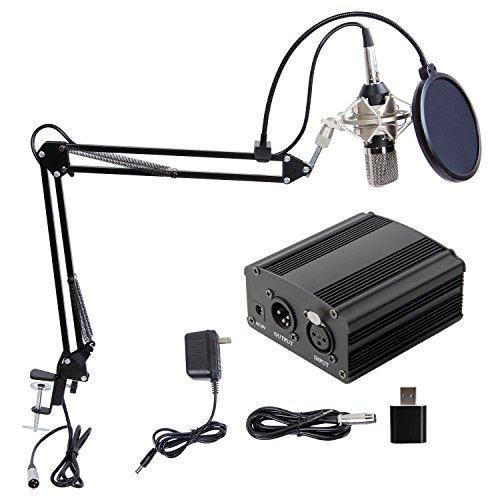
The first thing you notice about this microphone is that it comes with a whole kit.
This is ideal for anyone thinking about starting a Podcast or who just wants to make some YouTube content since you can get the whole package for dirt cheap.
When taking a look at the build quality you’ll find that it’s an all-metal body with a metal grille.
If you compare it to any of the high-end microphones, of course, it’s going to feel cheap and light, but for the price, I think that you’re actually getting a pretty good product.
The boom arm isn’t anything to brag about, but it will get the job done, as will the shock mount.
One pro about this mic is that you don’t necessarily need an audio interface to use it because it comes with an XLR to 3.5mm cable as well as a power supply.
You could use one, but it’s not needed.
All in all, I think I’d recommend the TONOR microphone kit to anyone who hasn’t got any experience with recording gear and who doesn’t already have an Audio Interface.
Specifications
| Polar Pattern | Cardioid |
| Microphone type | Condenser |
| Frequency Response | 20 to 12,000 Hz |
| Output Impedance | Impedance is 150 Ohms |
| Connector | Three-pin (XLR), male |
Find out more about the TONOR Pro Kit here:
- TONOR Pro Kit: Amazon.
Neewer NW-700 Condenser Microphone
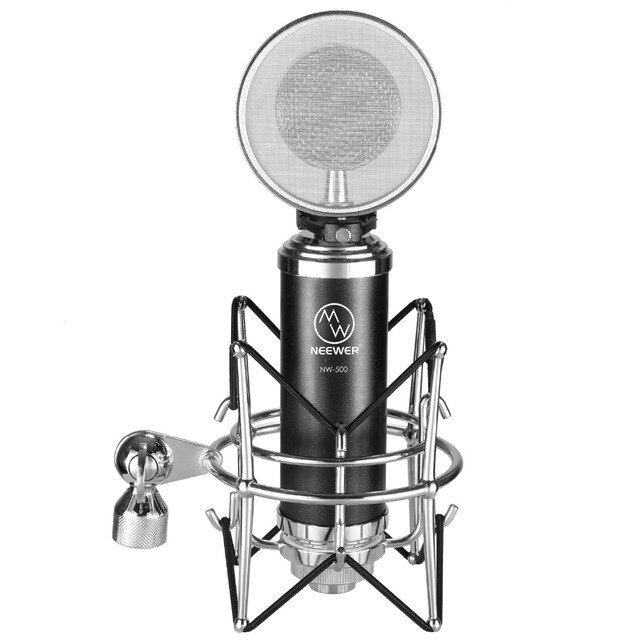
If there is one thing I like about this microphone, it’s got to be the way it looks.
It looks just like most of the Blue microphones; like the Blue Bluebird SL and some others, except that it doesn’t cost an arm and a leg.
I always loved the style of those microphones and the Neewer NW-500 has adopted it as well.
The Neewer NW-700 also comes with a kit that includes a windscreen, an XLR to 3-5mm cable, and a shock mount.
The only extra thing you’d need to get is a mic stand.
The build quality of the microphone is “decent” since it’s got an all-metal body and grille.
You can either connect the microphone using the 3.5mm cable or a regular XLR cable connected to your Audio Interface.
Note: Make sure if you’re using an Audio Interface to open up the mic and check that the power selection switch is correctly pushed in.
It will allow you to select between 48v, which should be used with the Audio Interface, and 5v, which should be used with the 3.5mm cable.
Specifications
| Polar Pattern | Cardioid |
| Microphone type | Condenser |
| Frequency Response | 20 to 20,000 Hz |
| Output Impedance | Impedance is 200 Ohms |
| Connector | Three-pin (XLR), male |
Find out more about the Neewer NW-700 here:
- Neewer NW-700: Amazon.
Behringer Ultravoice XM1800S (3 Dynamic Microphone Set)
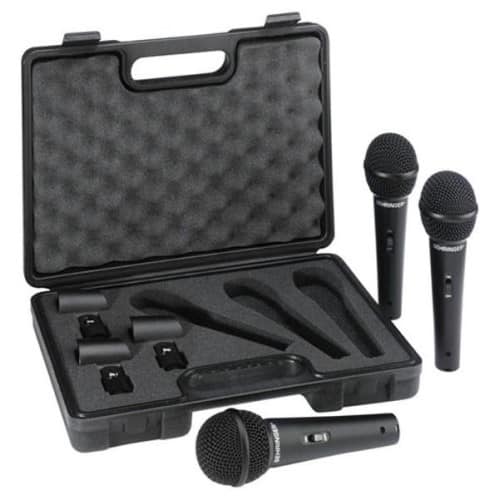
If you’re looking for an insanely cheap deal, then this set of three microphones might be for you;
You can get the three microphones for roughly the price of one Shure SM48, which makes it ideal for any band who just wants to get some cheap mics to practice with.
I wouldn’t recommend them for anything more serious, like recording properly, because even though they sound “ok”, if you really want affordable and professional sounding microphones, you should invest in something like the Shure SM58 or the Sennheiser e835.
When taking a look at the build quality you’ll find that they are actually quite sturdy and that they can take a beating.
Additionally, the carrying case that they come with is better than what you get with most higher-tier microphones.
The only feature worth noting is that these mics have an On/Off switch, but that’s about it.
All in all, I think that it’s a fantastic set and I would absolutely recommend it to anyone who needs a couple of super-cheap microphones for rehearsals.
Specifications
| Polar Pattern | Super-Cardioid |
| Microphone type | Dynamic |
| Frequency Response | 80 to 15,000 Hz |
| Output Impedance | Impedance is 600 Ohms |
| Connector | Three-pin (XLR), male |
Find out more about the Behringer Ultravoice XM1800S here:
- Behringer Ultravoice XM1800S: Amazon.
My Top Four Choices
Of all the microphones on this list I think that there are some that stand out, be it simply because of their sheer quality or because of their cost-efficiency.
The ones I’d recommend the most are;
USB Microphones
- Fifine 669B USB Mic: The reason is simply because of how cost-efficient it is.
- Moano AU-A04 USB Mic: Best audio quality.
XLR Microphones
- Behringer C-1 XLR Mic: Best Audio Quality.
- Behringer XM1800S (3 XLR Mic Set): Most cost-efficient.
However, if you have the budget then you should go with the Shure SM48 instead of the XM1800S (for dynamic microphone) since it’s that much better.
As I mentioned earlier, XLR microphones require Phantom Power which will be provided by the Audio Interface or Mixer.
I’ve written a couple of articles on the topic of Audio Interfaces which might be very useful to you, so make sure to check them out.
Conclusion
There are many more microphones out there, but the thing is that when you’re on a budget it’s hard to decide which one to get.
I hope this article made the decision easier for you and that you found the one mic that suited your needs.
I’d personally go with the Behringer C-1 for the simple fact that I own an Audio Interface… If you do too, I’d recommend that one.
Otherwise, any of the ones on this list should be fine!
Have a wonderful day!
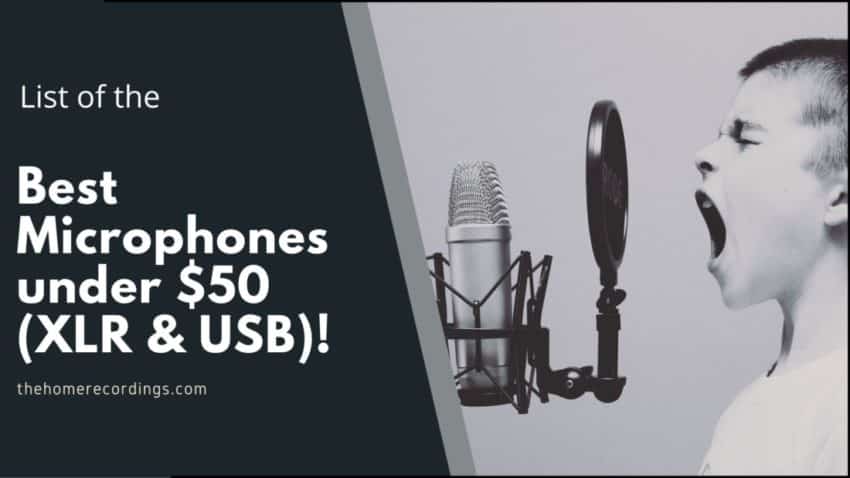
Do not buy the K670 fifine !!!
Do not buy from this low quality brand, this microphone is highly sensitive and does not provide microphone gain control for self voice monitoring. It catch a lot of background noise, it’s worse than my headset. Voice monitoring does not work well as it catch a very audible processing noise from the device.
Fifine Customer service refused to pay for a full refund and free return!!! Do not buy this product and brand!!